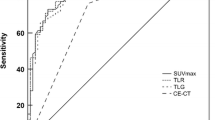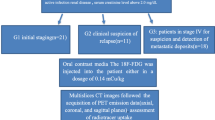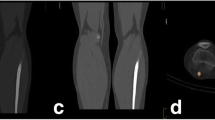Abstract
Purpose
To study the utility of positron emission tomography with computerized tomography (PET/CT) in patients with a stage I–III melanoma.
Patients and methods
PET/CT findings from all patients with a stage I–III melanoma attended at our hospital from September 2011 to November 2015 were reviewed.
Results
Data from 83 patients with a stage I–III melanoma, 39 patients with a positive sentinel lymph node biopsy (SLNB) and 35 patients with locoregional recurrences were analyzed. Sensitivity of PET/CT in clinical stage I–III patients was 5%, with a 14% of false positives. In patients with a positive SLNB, PET/CT previous to complete lymph node dissection had a 23% of false negatives. In patients with clinical locoregional recurrences, PET/CT findings revealed asymptomatic visceral distant metastasis in 25.7%.
Conclusions
PET/CT has a significant rate of false positive and negative results in patients with a stage I–III melanoma. Utility in patients with nodal locoregional recurrences seems higher than in patients with skin metastases.
Similar content being viewed by others

Explore related subjects
Discover the latest articles, news and stories from top researchers in related subjects.Avoid common mistakes on your manuscript.
Introduction
Cutaneous melanoma is responsible for 80% skin cancer-related deaths [1]. It is the fifth cancer in males and seventh in females in frequency. Incidence of melanoma has been rising quickly in recent decades, becoming 16% of diagnosed cancers worldwide [1].
Positron emission tomography with computerized tomography (PET/CT) has been used for staging and follow-up in patients with melanoma [2]. PET/CT scanners provide combined morphological and functional images, allowing for more accurate information about tumor spreading.
Although PET/CT is a useful procedure to evaluate responses to treatment in patients with disseminated melanoma, there is no consensuses of which are the indications to perform a PET/CT in patients with melanoma.
The objective of this study was to analyze the utility of PET/CT in patients with clinical stage I–III stage. We also analyze if PET/CT findings changed the indications of surgical procedures recommended in those patients.
Patients and methods
Data from all patients with cutaneous melanoma attended at our hospital from September 2011 to November 2015 were reviewed. Patients were followed up for at least three years or until their death. Final date of this study was 31 December 2017.
Inclusion criteria were those patients with melanoma for whom a PET/CT was performed in one of the following situations: (1) Staging patients with melanoma with a Breslow thickness (BT) deeper than 1.5 mm or BT ≤ 1.5 mm but with histological ulceration and no evidence of metastatic disease prior to sentinel lymph node biopsy (SLNB); (2) Staging patients with a positive sentinel lymph node biopsy (SLNB) prior to complete a complementary complete lymph node dissection (CLND); (3) Re-staging patients with locorregional recurrences detected during routine examination. We included both patients with clinically palpable suspicious lymphatic node and patients with clinical satellitosis or in transit-skin metastasis, although we analyze PET/CT findings separately.
Patients with mucosal, ocular or soft tissue melanoma or those with metastatic melanoma with unknown primary tumor were excluded. Patients with suspicious of malignancy findings in another image procedure previously performed were excluded. PET/CT reported as ambiguous were also excluded.
A nuclear medicine physician and a radiologist made the qualitative and semi-quantitative (SUVmax) analysis of the images. Pathological report was made when any lesion was identified on CT and/or any pathological 18F-fluorodeoxyglucose (FDG) uptake was detected.
On the basis of these indications, we determined accuracy of PET/CT findings were classified as follows: true positive (TP) when metastatic lesions were considered as malignant by the radiologist/nuclear medicine specialist report; true negative (TN) when non- metastatic lesions considered as such by the radiologist/nuclear medicine specialist report; false negative (FN) when metastatic lesions were not detected by PET/CT; false positive (FP) when non-metastatic lesions were considered as malignant by the radiologist/nuclear medicine specialist report. These results were validated with histological exams. With these results, we determined sensitivity, specificity, predictive positivity value (PPV) and predictive negativity value (PNV).
A retrospective, descriptive study was performed, including epidemiologic, clinic and histopathological data. All patients, prior to the imaging study, were asked to sign a consent form. Statistical analyses were conducted with SPSS 22.0 statistical program (SPSS Inc., Chicago, Illinois, USA).
Results
A total of 83 patients met the first inclusion criteria for the study. Table 1 shows demographic, clinical and histopathologic characteristics of included patients. It is highlighted that 21 (25.3%) were thick melanomas (> 4 mm BT), 41 (49.3%) had ulceration and 39 (47%) patients had ≥ 1 positive sentinel node. At the end of the study follow-up, 61 (73.5%) patients were alive and 22 (26.5%) had died because of melanoma. 39 patients with a positive SLNB a PET/CT was performed previous to CLND, so they met the second inclusion criteria for the study. 35 patients had clinical locorregional recurrences, twenty as skin metastasis (fourteen as cutaneous or subcutaneous satellitosis and six as in-transit metastasis) and fifteen as palpable lymphatic node, so the met the third inclusion criteria.
Table 2 shows PET/CT findings in all situations. Sixty-six (78.5%) of 83 patients with a clinical I–II stage at diagnosis had a PET/CT negative result, two (2.4%) had a true positive result (a positive sentinel node diagnosed further) and eleven (14%) a false positive result. Patients with false positives PET/CT findings had inflammatory pathologies (lymphadenitis, gastritis, hidradenitis, pulmonary infiltrates) or infections (pneumonia). Eight of these eleven patients underwent invasive examinations (endoscopy, bronchoscopy, ultrasound guided biopsy) to determine the very cause of PET/CT findings. Four of these patients were incidentally diagnosed of another primary tumor (adenocarcinoma of the colon (2), lung carcinoma, neuroendocrine tumor). PET/CT findings did not change indications of SLNB in any of these patients.
PET/CT findings in patients with positive SLNB previous to CLND were also showed in Table 2. In nine patients with a PET/CT reported as negative, histological examination from CLND showed at least one additional non-sentinel lymph node metastasis. Only in one patient, PET/CT findings (mediastinum node dissemination) cause of suspension of the programmed CLND.
Diagnostic significance of PET/CT findings in patients with melanoma is showed in Table 3. Overall average sensitivity and specificity of all PET/CT performed were 50.6% and 38.1%, respectively. Sensitivity of PET/CT in clinical stage I-II patients was 5% and PPV was 15.3%.
In patients with locorregional recurrences, PET/CT findings considered as true negative was zero because all those patients with a PET/CT report as negative developed disseminated metastases in the follow-up. These results explained that also specificity and predictive negativity value was zero.
Utility of PET/CT in patients with clinical locorregional recurrences analyzed both confirmations of clinical findings as long as asymptomatic disseminated metastases. Our results was better in patients with palpable lymph node recurrences than in patients with satellitosis or in-transit skin metastases, especially when in nine patients with skin locorregional metastases PET/CT was reported as without pathological findings.
PET/CT findings revealed asymptomatic visceral distant metastasis (lung, brain, bone, soft tissues) in nine of those patients (9/35; 25.7%), three with skin locorregional metastases and six with node locorregional metastases, so they were referred to Oncology department to be treated with systemic therapy.
Discussion
PET/CT is an imaging study with an expanding use in Oncology. Multiple studies have demonstrated utility of PET/CT for detection of distant metastasis on initial staging, follow-up and assessing therapy response [3,4,5]. Nevertheless, aggressive protocols incorporating CT or PET/CT scanning for the detection of metastasis from primary tumors appear to confer a significant substantial risk of a secondary malignant tumor [6].
There is no standard procedure image referred as technique to assess the clinical stage in localized melanoma. Although guidelines did not recommend routine imaging to screen for asymptomatic recurrence or metastatic disease [1], in daily practice many PET/CT are performed in different situations. In our study, we analyzed usefulness of PET/CT findings in patients with stage I–III melanomas and its impact on perform or not SLNB or CLND in those patients.
Usefulness of PET/CT for initial staging of patients with early stage melanoma is controversial and there is a discrepancy about its indication [7]. A cut-off point of 5 mm of BT has been proposed as the reference value to indicate a PET/CT study in patients with early stage melanoma because its prognostic value and discrimination capacity [8].
The results of our study are consistent with other studies about scarce utility of PET/CT for initial staging of patients with early stage melanoma, even those with high risk [7, 9,10,11,12].
By comparison, the proportion of false positive results was even less than other studies results [9, 11, 12]. This significant proportion of false positives lead to high psychological impact on patients and their families and result in cost increase due to diagnostic studies to confirm PET/CT findings, with an associated increase in morbidity very often. In addition, the resources used for this indication, could be employed to asses new-therapies response for advanced-stages melanoma patients, such as mutation-driven therapies [13] and immunotherapy [14]; scene where PET/CT seems to be more helpful.
PET/CT findings did not change the indication of SLNB in any patients from our study, and only in one patient PET/CT findings previous to CLND discouraged this surgical procedure. Moreover, a significance proportion of patients with a PET/CT reported as negative had sentinel and non-sentinel lymph node metastasis in SLNB and SNLD. Based on our results, some years ago we decided to not request PET/CT in these situations.
Utility of PET/CT in patients with nodal locorregional recurrences was higher than in patients with satellitosis or in-transit skin metastases. Limitations of PET/CT to detect skin metastases are explained by their smaller size and lower metabolism activity than node metastases.
In conclusion, PET/CT is an imaging study with great diagnosis accuracy but it has a high rate of false positives and implies high doses of radiation for the patients. Utility of PET/CT in patients with a stage I–II melanoma or in patients with a positive SLNB previous to a CLND is poor. Utility of PET/CT in patients with nodal locorregional recurrences seems higher than in patients with satellitosis or in-transit skin metastases [15].
References
NCCN Clinical Practice Guidelines in Oncology. Cutaneous melanoma version 1. 2019. Available from: https://www.nccn.org/professionals/physician_gls/pdf/cutaneous_melanoma.pdf. Accessed 1 Nov 2018.
Vercher-Conejero JL, Gámez Cenzano C. 18F-FDG positron emission tomography in oncology: main indications. Radiología. 2016;58:303–19.
Sachpekidis C, Larribere L, Pan L, Hberkorn U, Dimitrakopoulou-Strauss A, Hassel J. Predictive value of early 18F-FDG PET/TC studies for treatment response evaluation to ipilimumab in metastatic melanoma: preliminary results of an ongoing study. Eur J Nucl Med Mol Imaging. 2015;42:386–96.
Rohren EM. PET/computed tomography and patient outcomes in melanoma. PET Clin. 2015;10:243–54.
Perng P, Marcus C, Subramaniam R. 18F-FDG PET/TC and melanoma: staging, immune modulation and mutation-targeted therapy assessment, and prognosis. Nucl Med Mol Imaging (USA). 2015;205:259–70.
Wen J, Sai V, Straatsma B, McCannel T. Radiation-related cancer risk associated with surveillance imaging for metastasis from choroidal melanoma. JAMA Ophthalmol. 2013;131:56–61.
Klode J, Dissemond J, Grabbe S, Hillen U, Poeppel T, Boeing C. Sentinel lymph node excision and PET-CT in the initial stage of malignant melanoma: a retrospective analysis of 61 patients with malignant melanoma in American Joint Committee on Cancer stages I and II. Dermatol Surg. 2010;36(4):439–45.
Ortega-Candil A, Rodríguez-Rey C, Cano-Carrizal R, Cala-Zuluaga E, González JL, Jinénez A, et al. Breslow thickness and (18)F-FDG PET-CT result in initial staging of cutaneous melanoma: can a cut-off point be established? Rev Esp Med Nucl Imagen Mol. 2016;35:96–101.
Chessa MA, Dika E, Patrizi A, Fanti PA, Piraccini BM, Veronesi G, et al. Sentinel lymph node biopsy versus PET-TC in AJCC stages I and II of melanoma. J Eur Acad Dermatol Venereol. 2017;31:e54–5.
Schüle SC, Eigentler TK, Garbe C, La fougère C, Nikolaou K, Pfannenberg C. Influence of 18F-FDG PET/TC on therapy management in patients with stage III/IV malignant melanoma. Eur J Nucl Med Mol Imaging. 2016;43:482–8.
Gellén E, Sántha O, Janka E, Juhász I, Péter Z, Erdei I, et al. Diagnostic accuracy of 18F-FDG-PET/TC in early and late stages of high-risk cutaneous malignant melanoma. J Eur Acad Dermatol Venereol. 2015;29:1938–44.
Scheier B, Lao C, Kidwell K, Redman B. Use of preoperative PET/TC staging in sentinel lymph node-positive melanoma. JAMA Oncol. 2016;2:136–7.
van der Hiel B, Haanen JBAG, Stokkel MPM, Peeper DS, Jimenez CR, Beijnen JH, van de Wiel BA, Boellaard R, van den Eertwegh AJM, REPOSIT study group. Vemurafenib plus cobimetinib in unresectable stage IIIc or stage IV melanoma: response monitoring and resistance prediction with positron emission tomography and tumor characteristics (REPOSIT): study protocol of a phase II, open-label, multicenter study. BMC Cancer. 2017;2017(17):649.
Kong BY, Menzies AM, Saunders CA, Liniker E, Ramanujam S, Guminski A, Kefford RF, Long GV, Carlino MS. Residual FDG-PET metabolic activity in metastatic melanoma patients with prolonged response to anti-PD-1 therapy. Pigment Cell Melanoma Res. 2016;29:572–7.
Bourgeois A, Chang T, Fish L, Bradley Y. Positron emission tomography/computed tomography in melanoma. Radiol Clin N Am. 2013;51:865–79.
Funding
This study does not count on any financial support.
Author information
Authors and Affiliations
Corresponding author
Ethics declarations
Conflict of interest
IMR declares the following conflict of interest: advisory role from BMS, MSD, Novartis, Roche, Pierre Fabre, Incyte, Amgen, Merck-Serono, Sanofi, Regeneron and Bioncotech. The rest of the authors declare no conflict of interest with the specific topic.
Ethical approval
All patients, prior to the imaging study, were asked to sign a consent form. The study fulfills the declaration of Helsinki ethical standards for research.
Informed consent
Our research involved human participants who had obtained informed consents. The study fulfills the declaration of Helsinki ethical standards for research.
Additional information
Publisher's Note
Springer Nature remains neutral with regard to jurisdictional claims in published maps and institutional affiliations.
Rights and permissions
About this article
Cite this article
Avilés Izquierdo, J.A., Molina López, I., Sobrini Morillo, P. et al. Utility of PET/CT in patients with stage I–III melanoma. Clin Transl Oncol 22, 1414–1417 (2020). https://doi.org/10.1007/s12094-019-02252-2
Received:
Accepted:
Published:
Issue Date:
DOI: https://doi.org/10.1007/s12094-019-02252-2



